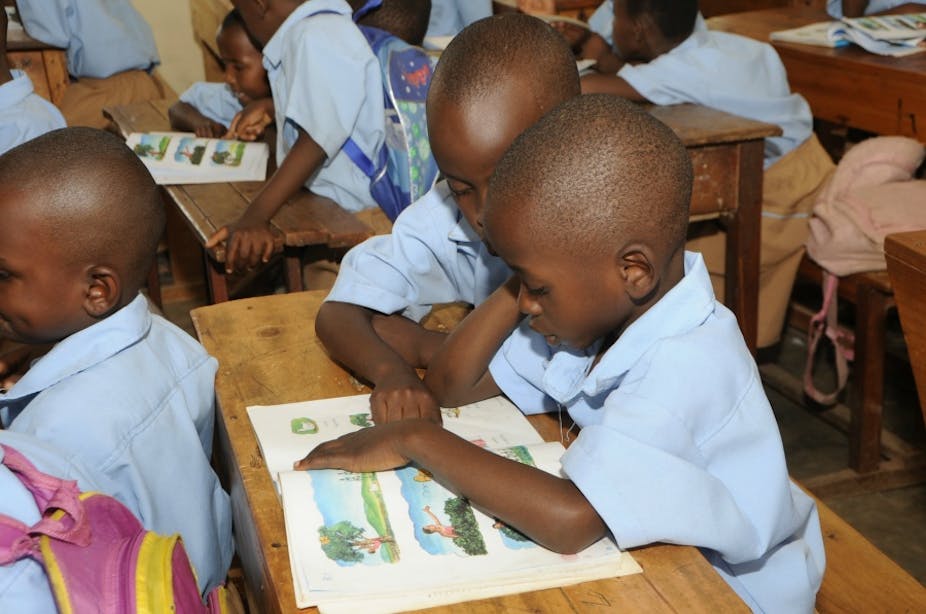Textbooks are a crucial part of any child’s learning. A large body of research has proved this many times and in many very different contexts. Textbooks are a physical representation of the curriculum in a classroom setting. They are powerful in shaping the minds of children and young people.
UNESCO has recognised this power and called for every child to have a textbook for every subject. The organisation argues that
next to an engaged and prepared teacher, well-designed textbooks in sufficient quantities are the most effective way to improve instruction and learning.
But there’s an elephant in the room when it comes to textbooks in African countries’ classrooms: language.
Rwanda is one of many African countries that’s adopted a language instruction policy which sees children learning in local or mother tongue languages for the first three years of primary school. They then transition in upper primary and secondary school into a dominant, so-called “international” language. This might be French or Portuguese. In Rwanda, it has been English since 2008.
Evidence from across the continent suggests that at this transition point, many learners have not developed basic literacy and numeracy skills. And, significantly, they have not acquired anywhere near enough of the language they are about to learn in to be able to engage in learning effectively.
I do not wish to advocate for English medium instruction, and the arguments for mother-tongue based education are compelling. But it’s important to consider strategies for supporting learners within existing policy priorities. Using appropriate learning and teaching materials – such as textbooks – could be one such strategy.
A different approach
It’s not enough to just hand out textbooks in every classroom. The books need to tick two boxes: learners must be able to read them and teachers must feel enabled to teach with them.
Existing textbooks tend not to take these concerns into consideration. The language is too difficult and the sentence structures too complex. The paragraphs too long and there are no glossaries to define unfamiliar words. And while textbooks are widely available to those in the basic education system, they are rarely used systematically. Teachers cite the books’ inaccessibility as one of the main reasons for not using them.
A recent initiative in Rwanda has sought to address this through the development of “language supportive” textbooks for primary 4 learners who are around 11 years old. These were specifically designed in collaboration with local publishers, editors and writers.
There are two key elements to a “language supportive” textbook.
Firstly, they are written at a language level which is appropriate for the learner. As can be seen in Figure 1, the new concept is introduced in as simple English as possible. The sentence structure and paragraph length are also shortened and made as simple as possible. The key word (here, “soil”) is also repeated numerous times so that the learner becomes accustomed to this word.

Secondly, they include features – activities, visuals, clear signposting and vocabulary support – that enable learners to practice and develop their language proficiency while learning the key elements of the curriculum.
The books are full of relevant activities that encourage learners to regularly practice their listening, speaking, reading and writing of English in every lesson. This enables language development.
Crucially, all of these activities are made accessible to learners – and teachers – by offering support in the learners’ first language. In this case, the language used was Kinyarwanda, which is the first language for the vast majority of Rwandan people. However, it’s important to note that initially many teachers were hesitant about incorporating Kinyarwanda into their classroom practice because of the government’s English-only policy.
Improved test scores
The initiative was introduced with 1075 students at eight schools across four Rwandan districts. The evidence from our initiative suggests that learners in classrooms where these books were systematically used learnt more across the curriculum.
When these learners sat tests before using the books, they scored similar results to those in other comparable schools. After using the materials for four months, their test scores were significantly higher. Crucially, both learners and teachers pointed out how important it was that the books sanctioned the use of Kinyarwanda. The classrooms became bilingual spaces and this increased teachers’ and learners’ confidence and competence.
All of this supports the importance of textbooks as effective learning and teaching materials in the classroom and shows that they can help all learners. But authorities mustn’t assume that textbooks are being used or that the existing books are empowering teachers and learners.
Textbooks can matter – but it’s only when consideration is made for the ways they can help all learners that we can say that they can contribute to quality education for all.

